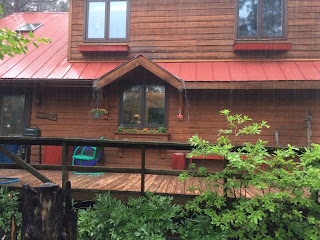Indigo Bunting
WINGIN’
IT
By
Kate Crowley
For a bird lover, June
is like a tempting buffet – or maybe I should say smorgasbord, considering where
we live. And at this time of year, we are ravenous, with eyes and ears having
been starved by the long and scarce winter rations. Now there are so many beautiful and melodic
sights and sounds that I find it hard to choose which to share with you. So I will make a compromise and talk about
one colorful species and a few of the songs we’re hearing.
Many of the birds who
return this way each spring come from the tropics and not surprisingly they
come arrayed in colorful plumage – far more extravagant than that which our
resident birds wear. (The one exception being the American goldfinch). Baltimore orioles, scarlet tanagers,
rose-breasted grosbeaks are just a few of the obvious arrivals arrayed in
flashy red and orange feathers. But
there is one small bird that is equally impressive when you see it in the right
light. That bird is the indigo bunting. Just slightly smaller than a goldfinch, this
Neotropical migrant has the conical shaped bill of a finch, but it is more
closely related to the grosbeaks and cardinals.
When seen in the shade it appears almost black, but let even a small
amount of light strike its body and its feathers seem almost fluorescent. It is hard to describe the color; the way the
deep blue glows and shines, but I guess indigo will have to suffice.
Last week we saw a
brown bird on one of the feeders that had us stumped. It wasn’t until Mike started paging through
the field guide that he hit upon female indigo bunting. As bright and beautiful as the male is, the
female is the opposite. The next day the
male showed up and he has been visiting the seed feeders ever since and we are
thrilled. Our hope is that the pair will
find a good nesting location on our property and raise a family. They usually
build their nests in dense shrubs or low trees.
Unlike some species, they do well in habitat that has been disturbed by
logging, highway or power line construction. Our land hasn’t been altered in
that way, but we do have a lot of shrubby vegetation on the forest edges.
Seeing the indigo
bunting by itself is a treat for the eye, but it was an even greater delight
when it landed on the feeder right next to a male goldfinch in all his blazing
glory. The two together were enough to make us catch our breath is awe.
Now for the songs: One of the benefits of years of watching and
studying birds is the ability to recognize them by their voices. For some species this is the only way we will
know they are here, because they are so well camouflaged or shy we never get a
look at them. People often marvel when
they hear us say, “that’s a chestnut-sided warbler” or “did you hear the
peewee?” There is no trick to this
ability; it is all about practice and repetition just as you would do learning
any foreign language.
Now that the sun is
rising ever earlier, so too are the birds.
With windows open I am awakened by the combination of light and
sound. Two different birds were singing
similar songs. One was singing ‘fee-bee,
fee-bee’, while the other was singing ‘phoebe ….. phoebeeee’. Do you know who I’m talking about? One is a bird that lives here year-round and
starts singing its courtship song as early as January. The other arrives in April and builds its cup
nest in our barn (above a light fixture) every year.
The first is the
black-capped chickadee and the second is the eastern phoebe. The chickadee’s two part call is first high
pitched and the second lower pitched, given over and over with a slightly
melancholy sound. The phoebe’s call (how
it came by its common name) is repeated at a faster pace, with the second
phrase having a vibrato at the end. It
is not often that you hear two different species of birds ‘saying’ almost the
same thing. Of course, we are using
mnemonics - putting words into the mouths of birds - to help us remember them
by. There are others we could discuss,
like the least flycatcher that says, ‘chebek, chebek’, but we’ll leave that for
another time.




Comments
Post a Comment